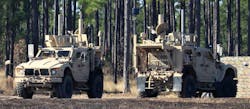General Dynamics asked to maintain and upgrade SIGINT sensors and vetronics to keep up with evolving threats
ABERDEEN PROVING GROUND, Md. – Military signals intelligence (SIGINT) experts at General Dynamics Corp. will maintain and upgrade combat vehicle SIGINT vetronics system to detect, identify, locate and deter a wide range of signal emissions on the battlefield.
Officials of the U.S. Army Contracting Command at Aberdeen Proving Ground, Md., announced $481.6 million contract to the General Dynamics Mission Systems segment in Scottsdale, Ariz., to sustain the AN/MLQ-44 Prophet-Enhanced SIGINT vetronics systems.
General Dynamics also will continue development and integration of technology insertion capabilities for the Prophet-Enhanced system to keep the systems up to date against an evolving threat.
The Prophet system is vehicle-mounted or soldier-transportable. Prophet offers a near-real-time picture of the battlespace through SIGINT sensors and high-performance computing.
The program is structured with the ability to incorporate new technologies as they become available. For example General Dynamics has used the RS112 1U rugged server from Crystal Group Inc. in Hiawatha, Iowa.
Prophet is the Army division and armored cavalry regiment commander's principal SIGINT and electronic warfare (EW) system. It also enhances the tactical commander's capabilities in electronic intelligence battlespace visualization, target development, and force protection. Prophet offers electronic attack and navigation attack capability.
The Prophet system also provides near-real-time digital information to the Army division's common operating picture (COP), and is integrated with battlefield sensors such as the Joint Surveillance Target Attack Radar System (Joint STARS), the Guardrail Common Sensor, Artillery Counter Mortar/Battery radars, and Forward Area Air Defense Command and Control/FAADC2.
Prophet's primary mission is to map radio frequency (RF) emitters on the battlefield electronically from 20 MHz HF frequencies to 2000 MHz SHF frequencies.
Related: Sensor and signal processing embedded computing at the speed of battle
Electronic mapping detects, identifies, locates, and tracks all RF emitters operating within range, and helps coordinate these RF signatures with other battlefield surveillance and reconnaissance systems.
Prophet helps protect Global Positioning System (GPS) satellite navigation, helps detect intrusion or false GPS signals, and helps attack the enemy's ability to use the GPS or other satellite navigation and timing systems. The system also can intercept, disrupt, or eavesdrop on enemy radio communications.
On this contract General Dynamics will do the work at locations to be determined with each order, and should be finished by January 2028. For more information contact General Dynamics Mission Systems online at https://gdmissionsystems.com, or the Army Contracting Command at Aberdeen Proving Ground at https://acc.army.mil/contractingcenters/acc-apg.
About the Author
John Keller
Editor-in-Chief
John Keller is the Editor-in-Chief, Military & Aerospace Electronics Magazine--provides extensive coverage and analysis of enabling electronics and optoelectronic technologies in military, space and commercial aviation applications. John has been a member of the Military & Aerospace Electronics staff since 1989 and chief editor since 1995.
